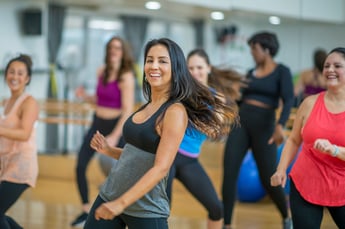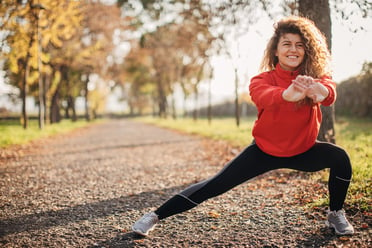 Movement is considered one of the best forms of preventive medicine to protect our health. In a general sense, the more we move, the healthier we tend to be. Movement isn’t restricted to structured exercises. Your body doesn’t really differentiate between walking up a flight of stairs or stepping on a stair climber. The wonderful thing about physical activity is that our bodies inherently know how to recover and adapt.
Movement is considered one of the best forms of preventive medicine to protect our health. In a general sense, the more we move, the healthier we tend to be. Movement isn’t restricted to structured exercises. Your body doesn’t really differentiate between walking up a flight of stairs or stepping on a stair climber. The wonderful thing about physical activity is that our bodies inherently know how to recover and adapt.
Why not work towards your health goals while surrounded by a community of like-minded people and listening to upbeat music? Here are some of the benefits you might see from joining in on Zumba or Hip-hop Dance at NIFS.
Rhythm, Positivity, & Community
Music has a way of connecting and bringing people together. Everyone coming into a dance class is there to either have fun, meet people, or find a new way to start moving. Our class keeps manageable intensity levels that are steady with the music beat. Zumba classes often follow a 128-140bpm cadence. The rhythm of the beat keeps the class fun while maintaining an aerobic intensity that is manageable and modifiable. Throughout the class, there are options for participants to modify their moves based on their comfort level and conditioning. Many people like Zumba and Hip-Hop dance because it is communal and there is a simple step of progression. The added challenges are optional, but almost everyone can join the basic moves.
The great thing is that there is no expectation of what level of skill you are at. Our instructors just ask that you move, have fun, and maybe share a smile. There is substantial evidence to support that dancing and being part of a group setting may be profoundly beneficial to our happiness and sense of well-being. You may make some friends and look forward to taking those steps together in every class.
Benefits to Cardiovascular Health
Engaging in steady state aerobics like Hip-Hop dance or Zumba could be a more enjoyable alternative to things like running if that is not your interest. You can reap many of the same benefits of other options in these fun classes, while listening to modern classics and uplifting beats. Many participants prefer to meet their aerobic activity goals in these dance classes. You’ll enjoy this form of exercise because everyone is moving at their own pace, having fun, while supporting their overall health.
Muscle Tone and Strength
Participating in Zumba and Hip-hop dance can activate all the muscles in your body. While the intensity is up to you, muscle activation across the whole body will promote total body muscle tone and development as you move. Dance requires a lot of core stability and movement through full ranges of motion, so expect to use your whole body and not just your lower body.
Coordination and Dance Skills
Stability and motor skills develop through frequency of movement, not necessarily intensity. As you join these fun dance classes, you may notice your body control and coordination will improve gradually. Learning how to dance is also a life skill you’ll take home with you. If you aren’t a natural dancer, that is okay. As you stay consistent with classes, you’ll improve those two left feet you started with. Many people getting into dance for the first time rejoice as they notice their motor skills improve and translate to other aspects of their training. Even athletes can notice benefits by integrating dance into their routine.

 Intuitive eating is the practice of eating in response to your body’s internal hunger and fullness cues, rather than external cues, such as environmental or social triggers that prompt eating behaviors, regardless of true hunger or fullness levels. In today’s society, it is especially difficult to eat intuitively as we are near constantly being bombarded with messaging that tells us what we should or shouldn’t eat and that labels foods as “good” or “bad.” Overtime, as the mind and body become used to ignoring hunger signals, the cues begin to fade and are more and more difficult to notice or may only be noticed when the body is in an extreme, ravenous state, which is likely to lead to overeating, which is then followed by feelings of guilt and desire to restrict based on external cues and continued ignoring of internal hunger cues. For many, the body must be reconditioned, starting with reconnecting with your biological hunger cues. Here’s how to start:
Intuitive eating is the practice of eating in response to your body’s internal hunger and fullness cues, rather than external cues, such as environmental or social triggers that prompt eating behaviors, regardless of true hunger or fullness levels. In today’s society, it is especially difficult to eat intuitively as we are near constantly being bombarded with messaging that tells us what we should or shouldn’t eat and that labels foods as “good” or “bad.” Overtime, as the mind and body become used to ignoring hunger signals, the cues begin to fade and are more and more difficult to notice or may only be noticed when the body is in an extreme, ravenous state, which is likely to lead to overeating, which is then followed by feelings of guilt and desire to restrict based on external cues and continued ignoring of internal hunger cues. For many, the body must be reconditioned, starting with reconnecting with your biological hunger cues. Here’s how to start: As the days grow shorter and temperatures drop, finding motivation to get to the gym can be tough. Between an increase in sickness, schedule changes, and chilly weather, it’s easy to lose your fitness rhythm. But sticking with your exercise routine during this time of year can actually help you feel better. Regular movement can boost your immunity, improve your mood, and increase your overall energy levels.
As the days grow shorter and temperatures drop, finding motivation to get to the gym can be tough. Between an increase in sickness, schedule changes, and chilly weather, it’s easy to lose your fitness rhythm. But sticking with your exercise routine during this time of year can actually help you feel better. Regular movement can boost your immunity, improve your mood, and increase your overall energy levels..jpg?width=254&height=169&name=GettyImages-1053000236%20(1).jpg) Tips for Staying Active
Tips for Staying Active
 Weightlifting and resistance training are often associated with the “gym bro” or “jock” stereotype, as if the benefits only apply to people chasing new personal records or aesthetic goals. Because of that mindset, some might find it surprising to see an older adult in the weight room. If not to build muscle or break performance barriers, what’s the point? Wouldn’t it be dangerous for someone in their 50s, 60s, or beyond to lift weights? Surely nothing good could come from someone “older” picking up heavy objects regularly, right?
Weightlifting and resistance training are often associated with the “gym bro” or “jock” stereotype, as if the benefits only apply to people chasing new personal records or aesthetic goals. Because of that mindset, some might find it surprising to see an older adult in the weight room. If not to build muscle or break performance barriers, what’s the point? Wouldn’t it be dangerous for someone in their 50s, 60s, or beyond to lift weights? Surely nothing good could come from someone “older” picking up heavy objects regularly, right? When you hear the phrase “speed training,” it’s easy to picture elite athletes—sprinters blasting off the line or pros flying down the field. But speed training isn’t reserved for them. Anyone can benefit from learning to move more efficiently, react faster, and generate more power. In fact, adding a little speed work to your weekly routine can help you feel stronger, more coordinated, and more confident in your movement—whether you’re running, lifting, or chasing your kids around the yard.
When you hear the phrase “speed training,” it’s easy to picture elite athletes—sprinters blasting off the line or pros flying down the field. But speed training isn’t reserved for them. Anyone can benefit from learning to move more efficiently, react faster, and generate more power. In fact, adding a little speed work to your weekly routine can help you feel stronger, more coordinated, and more confident in your movement—whether you’re running, lifting, or chasing your kids around the yard. You can also obtain creatine through supplements.
You can also obtain creatine through supplements. 
 In small amounts, free radicals are part of your body’s defense system. But in excess, they can damage cells and may play a role in cancer, heart disease, stroke, arthritis, vision loss, and even brain conditions like Parkinson’s or Alzheimer’s disease.
In small amounts, free radicals are part of your body’s defense system. But in excess, they can damage cells and may play a role in cancer, heart disease, stroke, arthritis, vision loss, and even brain conditions like Parkinson’s or Alzheimer’s disease. Back-to-school season is a great time for a fresh start - whether you’re a student, parent, or both! However, as your schedule changes and so does the season, there are many obstacles to getting or staying on track when it comes to your nutrition, exercise and other health-related goals. From having to wake up earlier to help the kids get ready for school to having to stay up late to complete school assignments, many factors can disrupt your usual eating, sleeping, or exercising routines. To stay ahead of these disruptions, the best strategy is to have a plan. Begin thinking about how the change to your schedule may require you to adjust your eating or exercise routines. Does the start of the school year mean you will have to get up earlier to get your workout in before you see the kids off to school? Will a late-night class or evening sports practice interfere with your usual dinner routine? If so, what adjustments need to be made to help you stay on track?
Back-to-school season is a great time for a fresh start - whether you’re a student, parent, or both! However, as your schedule changes and so does the season, there are many obstacles to getting or staying on track when it comes to your nutrition, exercise and other health-related goals. From having to wake up earlier to help the kids get ready for school to having to stay up late to complete school assignments, many factors can disrupt your usual eating, sleeping, or exercising routines. To stay ahead of these disruptions, the best strategy is to have a plan. Begin thinking about how the change to your schedule may require you to adjust your eating or exercise routines. Does the start of the school year mean you will have to get up earlier to get your workout in before you see the kids off to school? Will a late-night class or evening sports practice interfere with your usual dinner routine? If so, what adjustments need to be made to help you stay on track? imilarly to your eating routine, consider what changes must be made to maintain your exercise goals or if your exercise goals need to be reevaluated. Ask yourself: when can I realistically fit exercise/activity into my new routine/schedule? Do I need to make adjustments to the frequency or length of my activities? Are there other ways I can be active if my schedule doesn’t allow for structured exercise? For example - park the car further away from the store/office, take 5 minute breaks periodically between assignments or work tasks to get some
imilarly to your eating routine, consider what changes must be made to maintain your exercise goals or if your exercise goals need to be reevaluated. Ask yourself: when can I realistically fit exercise/activity into my new routine/schedule? Do I need to make adjustments to the frequency or length of my activities? Are there other ways I can be active if my schedule doesn’t allow for structured exercise? For example - park the car further away from the store/office, take 5 minute breaks periodically between assignments or work tasks to get some  Adequate energy is needed for all bodily processes, including essential functions like keeping your heart beating, your lungs breathing, and maintaining your body temperature within range, as well as other activities like day-to-day movement and structured exercise.
Adequate energy is needed for all bodily processes, including essential functions like keeping your heart beating, your lungs breathing, and maintaining your body temperature within range, as well as other activities like day-to-day movement and structured exercise.